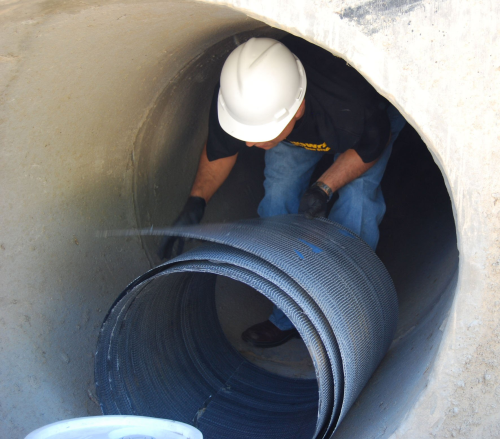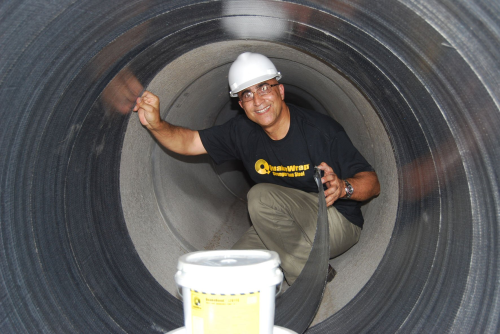

Compared to many existing wet lay-up, in situ methods, the PipeMedic system is said to be much faster to install, offer more consistent and uniform mechanical properties, and does not rely on the laminating skills of the installation team.
With PipeMedic, the FRP linings are manufactured under controlled conditions offsite and custom made using glass or carbon fabrics and an epoxy resin matrix to meet the specific pressure requirements of the application. Once cured the finished laminates are rolled up in approximately a 300 mm diameter coil for ease of shipment and installation.
Once on site a high viscosity epoxy adhesive is applied to the back face of the lining using a notched trowel and the lining is re-rolled. When the coil is carefully opened inside the pipe, the lining operates very much like a loaded spring, pushing itself against the inner surface of the pipe. Depending on the application, the PipeMedic lining can be applied in single rings or as a continuous spiral. In the case of culvert repairs and small or inaccessible pipes, the laminates can be rolled up along the longitudinal axis. In terms of installation speed QuakeWrap maintains that its system can be installed in as little as a tenth of the time of a conventional wet lay up system.
Currently the PipeMedic FRP linings can be supplied to meet pressures from 4000 to 10 000 bar. QuakeWrap maintains that system is suitable for all cylindrical structures (e.g. pipes, tanks, silos) that have a minimum diameter of 300 mm.
When carbon-based laminates are specified for steel or iron pipes, a thin fibreglass barrier is incorporated to prevent galvanic corrosion.
Arizona-based QuakeWrap is currently looking to partner companies outside the USA to distribute and install the PipeMedic system.
Rehabilitation project
QuakeWrap was established in 1994 to develop FRP systems to repair and strengthen existing structures. In addition to PipeMedic, the company also produces wet laminating-based systems and has recently completed the rehabilitation of a 1.7 km long, 2.1 m diameter, pressurised concrete pipeline approximately 70 miles from San José in Costa Rica.
This is believed to be the largest in-place, full structural and waterproofing rehabilitation project of its type. A total of 14 000 m2 of FRP liner was installed in 15 days.
The pipeline conveys river water under pressure from the source to hydro-electric generating units. Due to problems in the structural design, the pipeline developed longitudinal fissures that extended the entire length of the pipeline. These fissures caused major leaks upon pressurisation of the pipeline. The FRP lining has increased the original design pressure of the pipeline by approximately 90% and at the same time offers superior corrosion resistance and waterproofing properties.





